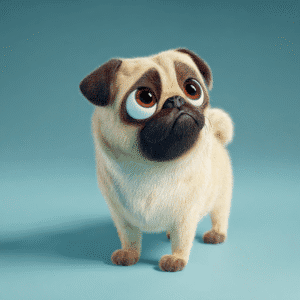The Pug has been stealing hearts for centuries. Originally from China, Pugs became fashionable in England when Dutch traders brought them to Europe. Queen Victoria adored them, helping to cement their popularity in the UK.
With their big round eyes, wrinkled faces, and clownish charm, Pugs are one of the most recognisable and loved breeds. Their main goal in life? To snuggle up on your lap and make you laugh.
Pug Traits at a Glance
- Best trait: Playful and affectionate
- Challenging trait: Heavy shedding
- Weight: 6–8 kg
- Height: 18–20 cm
- Lifespan: 12–15 years
Exercise Needs
Pugs don’t need huge amounts of exercise, making them great for flat or apartment living. A short daily walk and plenty of indoor play will keep them content. They hate the rain, so house-training may be tricky!
Remember, even small dogs can become mischievous when bored — nuisance barking, chewing, or digging can all appear without stimulation.
Temperament
Pugs are cheerful, sensitive, and people-focused. They love nothing more than being with their family, usually forming a close bond with one special person.
They’re playful companions for older children, but not ideal for households with toddlers, as they don’t enjoy being pulled around.
Above all, Pugs are lapdogs at heart. They thrive on affection and struggle when left alone for long periods, often developing separation anxiety.
Watchdogs and Strangers
Don’t expect much guarding ability here. Pugs will happily alert you to someone at the door, but once a stranger comes inside, they’re usually treated as a new friend.
Living With a Pug
- With other pets: Peaceful with other dogs and cats if raised together.
- With small animals: Generally fine, but supervision is always wise.
- Heat sensitivity: Pugs are prone to overheating due to their short muzzles. Keep them cool in hot weather.
Training a Pug
Pugs are intelligent but sensitive. Positive reinforcement is essential — harsh methods will only cause them to sulk or shut down.
They can be stubborn, particularly when it comes to going outside in the rain. Keep training fun, light, and consistent for the best results.
For practical help with training, recall, or housebreaking, check out Pickles, our AI Dog Trainer, designed to support new puppy owners step by step.
Grooming Needs
- Short coat, but heavy year-round shedders
- More intense shedding in spring and autumn
- Weekly brushing helps manage loose hair
- Simple to groom compared to longer-coated breeds
Pros and Cons of Owning a Pug
| Pros | Cons |
|---|---|
| Playful and affectionate | Heavy shedding despite small size |
| Great for apartments and small homes | Prone to separation anxiety |
| Cheerful companions with big charm | Can be stubborn with house-training |
| Easy grooming routine | Sensitive to heat and prone to issues |
Health Notes
Pugs are prone to several health concerns, including:
- Brachycephalic airway issues – breathing difficulties due to their short muzzle
- Eye problems – ulcers and injuries are common because of prominent eyes
- Obesity – Pugs love food and need careful portion control
If you’re considering a Pug puppy, download our Best in Breeder Guide to ensure you know the right health questions to ask.
History & Background
The Pug’s origins stretch back to China, where they were bred as companion dogs for royalty. By the 16th and 17th centuries, Dutch traders introduced them to Europe, where they quickly became favourites among monarchs and aristocrats.
Queen Victoria kept and bred Pugs, and later European royals continued the trend. Once nearly extinct in the UK, Pugs regained popularity in the 19th century when more breeding stock was imported from the continent.
Famous Pug Owners
Pugs have long been adored by royals, celebrities, and artists:
- Queen Victoria – a devoted Pug lover.
- Napoleon Bonaparte’s wife, Josephine – kept a Pug named Fortune.
- Valentino – the fashion designer, famous for his ever-present pack of Pugs.
- Gerard Butler – Hollywood actor and proud Pug owner.
Great Names for Pugs
Their comical charm and royal past inspire some fun and fitting names.
Cute Names
Peanut, Noodle, Biscuit, Tilly
Regal Names
Victoria, Duke, Pearl, Caesar
Playful Names
Muffin, Pickle, Gizmo, Bubbles
Need more ideas? Try our Dog Name Generator for customised suggestions.
Thinking of Bringing Home a Pug?
The Pug is a playful, comical, and endlessly affectionate breed. They make fantastic companions for those who can give them time, attention, and cuddles, but they’re not suited for long hours alone.
Make the early weeks smoother with our New Puppy Paw-rent Planner, which includes trackers, routines, and training tips to help you every step of the way. And if you want to capture their cheeky personality forever, our Cartoon Pet Portraits are a perfect keepsake.
Pickles’ Aside:
“Pugs are proof that big personalities come in small, wrinkly packages. Just don’t expect them to go out in the rain without a dramatic protest.”
Pug Stats
- Origin: China, popularised in England
- Weight: 6–8 kg
- Height: 18–20 cm
- Lifespan: 12–15 years
- Best trait: Playful and affectionate
- Challenging trait: Heavy shedding

